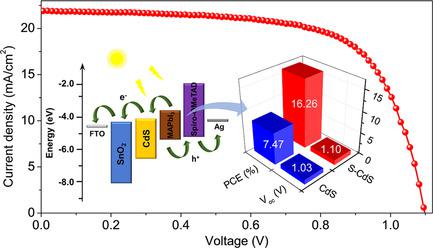Our official English website, www.x-mol.net, welcomes your
feedback! (Note: you will need to create a separate account there.)
Colloidal SnO2-Assisted CdS Electron Transport Layer Enables Efficient Electron Extraction for Planar Perovskite Solar Cells
Solar RRL ( IF 6.0 ) Pub Date : 2021-07-28 , DOI: 10.1002/solr.202100494 Juntian Zhou 1 , Ru Zhou 1 , Jun Zhu 2 , Ping Jiang 1 , Lei Wan 1 , Haihong Niu 1 , Linhua Hu 3 , Xi Yang 1 , Jinzhang Xu 1 , Baomin Xu 4
Solar RRL ( IF 6.0 ) Pub Date : 2021-07-28 , DOI: 10.1002/solr.202100494 Juntian Zhou 1 , Ru Zhou 1 , Jun Zhu 2 , Ping Jiang 1 , Lei Wan 1 , Haihong Niu 1 , Linhua Hu 3 , Xi Yang 1 , Jinzhang Xu 1 , Baomin Xu 4
Affiliation

|
The cadmium sulfide (CdS) is a promising electron transport layer (ETL) material for perovskite solar cells (PSCs) due to its low photocatalytic activity toward perovskite materials under UV light. The critical problem responsible for the moderate performance of CdS-based PSCs is the parasitic light absorption of CdS, which drives researchers to deposit ultrathin ETLs. However, the ultrathin ETL often involves the undesirable shunt current leakage because of the direct contact between conducting substrate and perovskite layer. Herein, a fully low-temperature solution-processed colloidal SnO2-assisted CdS (S-CdS) ETL for planar CH3NH3PbI3 PSCs is constructed. The detailed characterizations of morphological, optical, and energy levels confirm that the assistance of colloidal SnO2 provides the ameliorated continuity, reduces surface roughness and superior wettability of ETLs for high-quality perovskite formation as well as the favorable cascade band structure for efficient charge transfer. The study of charge transfer mechanisms reveals that the S-CdS ETL effectively inhibits the shunt leakage, promotes the electron extraction and suppresses the charge recombination at the ETL/perovskite interface. Consequently, the S-CdS ETL-based PSCs deliver an appreciable efficiency of 16.26%, doubling that of conventional CdS-based devices. To the best of our knowledge, this value is the champion efficiency reported for CdS-based CH3NH3PbI3 PSCs.
中文翻译:

胶体 SnO2 辅助 CdS 电子传输层为平面钙钛矿太阳能电池提供高效电子提取
硫化镉 (CdS) 是一种很有前途的电子传输层 (ETL) 材料,用于钙钛矿太阳能电池 (PSC),因为它在紫外光下对钙钛矿材料的光催化活性较低。导致基于 CdS 的 PSC 性能适中的关键问题是 CdS 的寄生光吸收,这促使研究人员沉积超薄 ETL。然而,由于导电衬底和钙钛矿层之间的直接接触,超薄 ETL 经常涉及不良的分流漏电流。在此,用于平面 CH 3 NH 3 PbI 3的完全低温溶液处理的胶体 SnO 2辅助 CdS (S-CdS) ETL构建 PSC。形态、光学和能级的详细表征证实胶体 SnO 2的帮助提供了改善的连续性,降低了 ETL 的表面粗糙度和优异的润湿性,以形成高质量的钙钛矿,以及有利的级联带结构,以实现有效的电荷转移. 电荷转移机制的研究表明,S-CdS ETL有效地抑制了分流泄漏,促进了电子提取并抑制了ETL/钙钛矿界面处的电荷复合。因此,基于 S-CdS ETL 的 PSC 提供了 16.26% 的显着效率,是传统的基于 CdS 的设备的两倍。据我们所知,该值是基于 CdS 的 CH 3报告的最佳效率NH 3 PbI 3 PSC。
更新日期:2021-09-09
中文翻译:

胶体 SnO2 辅助 CdS 电子传输层为平面钙钛矿太阳能电池提供高效电子提取
硫化镉 (CdS) 是一种很有前途的电子传输层 (ETL) 材料,用于钙钛矿太阳能电池 (PSC),因为它在紫外光下对钙钛矿材料的光催化活性较低。导致基于 CdS 的 PSC 性能适中的关键问题是 CdS 的寄生光吸收,这促使研究人员沉积超薄 ETL。然而,由于导电衬底和钙钛矿层之间的直接接触,超薄 ETL 经常涉及不良的分流漏电流。在此,用于平面 CH 3 NH 3 PbI 3的完全低温溶液处理的胶体 SnO 2辅助 CdS (S-CdS) ETL构建 PSC。形态、光学和能级的详细表征证实胶体 SnO 2的帮助提供了改善的连续性,降低了 ETL 的表面粗糙度和优异的润湿性,以形成高质量的钙钛矿,以及有利的级联带结构,以实现有效的电荷转移. 电荷转移机制的研究表明,S-CdS ETL有效地抑制了分流泄漏,促进了电子提取并抑制了ETL/钙钛矿界面处的电荷复合。因此,基于 S-CdS ETL 的 PSC 提供了 16.26% 的显着效率,是传统的基于 CdS 的设备的两倍。据我们所知,该值是基于 CdS 的 CH 3报告的最佳效率NH 3 PbI 3 PSC。











































 京公网安备 11010802027423号
京公网安备 11010802027423号